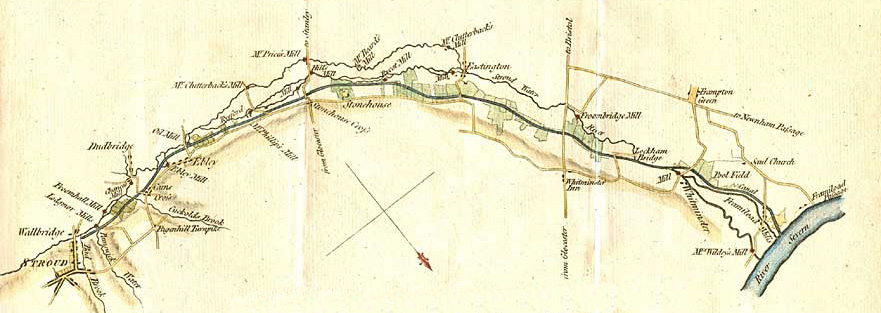A brief account of how the canal fared over eight periods.
In the eighteenth century, the Stroud valley was a major centre for the production of woollen cloth, and there was a growing need for more coal. As road conditions at the time were poor, local men obtained an Act of Parliament in 1730 to authorise making the River Frome navigable for barges between Framilode on the River Severn and Wallbridge in the town of Stroud. However, there was strong opposition from local mill owners who feared that much water would bypass their mills, and no construction work was started. After other attempts to make the river navigable came to nothing, another group obtained a new Act in 1776 authorising a canal to be built alongside the river, and this was opened with great ceremony in 1779.

The new Stroudwater Canal immediately had the effect of reducing the price of coal in Stroud, and a good trade developed. Prospects improved further when another group of investors built the Thames & Severn Canal from Stroud to the River Thames near Lechlade, opened in 1789. This provided a direct link between London and the west of England at a time when the alternative coastal route was risky because of the war with France. The main cargo carried on both canals was coal from Bristol, South Wales and the Midlands, and other bulk cargoes included grain, timber and road stone. In the early days some traders also did good business carrying multiple small consignments of manufactured products, household goods and luxury imports.
Trade was boosted in the 1810s when tramroads opened in the the Forest of Dean bringing coal down to small docks at Bullo Pill and Lydney. These soon provided the main source of industrial coal for the Stroud valley. Prospects were improved further in 1827 with the opening of the Gloucester & Berkeley Canal which intersected the Stoudwater Canal at Saul Junction. This had the effect of providing a safe route for narrow canal boats travelling between the Stroud valley and the Midland coalfields by avoiding the tidal waters of the River Severn below Gloucester. A further benefit was that foreign imports arriving in Gloucester were available as a north-bound cargo for boats bringing coal south. Helped by these favourable circumstances, the Stroudwater Company became the most profitable canal company in the south of England, with annual dividends averaging 17% in the early 1830s.
This outstanding success became clouded, however, as railways began spreading across the country. Initially they brought additional traffic as huge quantities of wooden sleepers. iron rails and other materials were delivered to construction sites, particularly for the Bristol to Gloucester line opened in 1844 and the GWR line through Stroud opened in 1845. Once these were open, however, the Stroudwater Company had to reduce its tolls to match railway rates, although long distance traffic through to the Thames Valley was still badly hit.
The local woollen cloth industry was also going through difficult times with mills closing due to competition from Yorkshire, but some local entrepreneurs took advantage of a new opportunity provided by the Repeal of the Corn Laws in 1846. This measure allowed high quality foreign grain to flood into ports like Bristol and Gloucester, creating a demand for more milling facilities with good transport connections. As a result, several redundant cloth mills in the Stroud valley were converted to corn milling, and barges were built to bring the corn to the mills and to take the flour back in return.
Although this new trade helped to keep the canal prosperous for a few more years, there was further competition in 1867 with the opening of the Stonehouse & Nailsworth Railway which ran right through important areas served by the canal. Also, through traffic to the Thames & Severn Canal was affected by the opening of the East Gloucestershire Railway to Fairford in 1873. These developments meant that tolls on both canals had to be reduced further, and the condition of the Thames & Severn Canal deteriorated as there was not enough income to keep it maintained properly.
In spite of the increased competition, the Stroudwater Canal continued to remain profitable well into the twentieth century as it served a good number of canal-side industries, and the management went to great efforts to maintain existing users and to seek out new ones. Over the years, however, some users installed rail sidings and others moved their businesses to suit rail transport. Furthermore, the Thames & Severn Canal continued to deteriorate, and the summit level had to be closed for several years while restoration work was carried out by Gloucestershire County Council. As traffic continued to be lost to the railways, the Stroudwater Company paid its last dividend in 1922, the Thames & Severn Canal was abandonded in 1933, and the last Stroudwater toll was collected in 1941.
Remarkably, the old Stroudwater management soldiered on until an Act of Parliament in 1954 created a new way of working. The primary aim of the Act was to end the right of navigation along the canal and to allow the County Council to replace the ancient hump-back and swing bridges with low level fixed structures more suited to road traffic. At the same time, a new board of management was appointed to run the Company in the interests of the community. Initially the new directors had to cooperate with schemes put forward by other public bodies, and there was no thought of restoration. In the 1970s, however, they did begin to support restoration work organised by what became the Cotswold Canals Trust, and now the canal is well on the way to full restoration with the help of major external grants. Meanwhile the Company of Proprietors (as they are now known), which is still the legal owner of the canal, has been recognised as the oldest suviving canal company in the country.